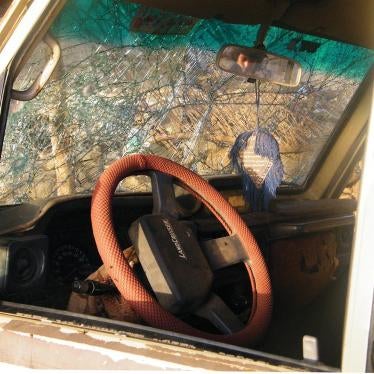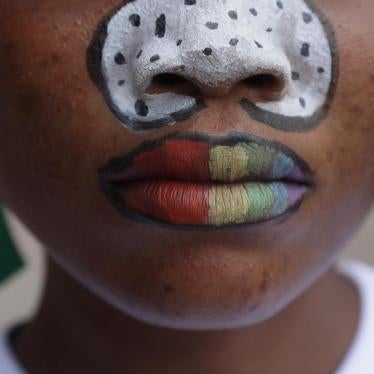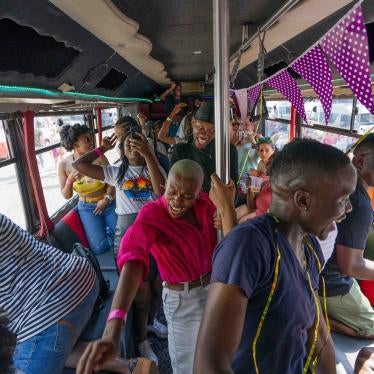(Kampala, September 10, 2014) – Uganda’s authorities have never investigated killings by security forces during two days of rioting in September 2009 that left at least 40 people dead. Despite numerous promises to investigate over the past five years, no police or military members have been held accountable for the killings.
“For the last five years, the victims’ families have waited for justice for the deaths of their loved ones and the government has turned its back on them,” said Maria Burnett, senior Africa researcher. “The failure to investigate any case involving a soldier or police officer relating to the September 2009 events shows a serious disregard for rule of law and a government unconcerned about people’s lives.”
On September 10 and 11, 2009, authorities sought to prevent the cultural leader of the Buganda ethnic group from traveling to Kayunga, a town near Kampala. His supporters took to the streets, in some instances throwing stones and setting debris, unoccupied vehicles, and an unoccupied police post alight. In response military and police began beating people and quickly used live ammunition, killing unarmed protesters and bystanders.
Sources at Kampala’s main hospital, Mulago, indicated that 88 victims of the violence were admitted for treatment related to the riots, most for gunshot wounds. Victims were taken to other hospitals as well. The government officially maintains that only 27 people lost their lives, largely as a result of “stray bullets” fired by security personnel deployed on armored personnel carriers. Hospital records and local organizations put the death toll at over 40.
Human Rights Watch investigated 13 separate incidents and documented several in which security forces shot live ammunition through the closed doors of peoples’ homes, killing those inside. For example, military units, some accompanied by police forces, deployed to Ndeeba on September 10 and ordered people on the roads to return home. Witnesses told Human Rights Watch that uniformed soldiers, some wearing the red berets of the military police, began to attack people with sticks and batons to clear the streets.
A man from Ndeeba told Human Rights Watch:
The soldiers began to hit us with batons and kick us. They were beating other people in the road as well. I ran away and noticed I had a cut on my head from the baton, and I was bleeding. My friend and I went off the main road and hid by locking ourselves into a storage room near a friend’s shop. We heard the soldier’s footsteps and then he yelled, “Open the door!” I said, “But if we come out, you are going to beat us again.” He said, “You think bullets cannot reach you in there?” Then he fired his gun through the door. A bullet hit the inside of my arm and then entered my stomach and I fell down.
Over several hours, soldiers shot and killed one person and seriously wounded two more in Ndeeba. In each case, the victims were shot after they had entered their homes or workplaces. Kinaalwa Sseddulaaka Jackson, the owner of a dry cleaning shop, was hiding in his back storage room when witnesses outside saw a uniformed soldier shoot an AK-47 through the locked door. Sseddulaaka died instantly. Human Rights Watch researchers saw two bullet holes in that door, as well as five other bullet holes in doors and walls in the neighborhood. All were in the lower half of the doors and walls.
The following day in Busega, an area dense with open-air shops and stalls, soldiers shot and killed two people in separate incidents. Residents and officials reported that on September 10, rioters in the area had blocked roads with fires and demanded money from those trying to enter Kampala by car. The rioters also looted and burned a Coca Cola truck. Witnesses told Human Rights Watch that the area remained calm until the morning of September 11 when a military armored personnel carrier and military and police trucks drove through, allegedly to tell people to clear the streets and return home. The shops closed quickly when soldiers began firing live bullets.
Thirteen-year-old Daoudi Ssentongo was struck in the head and killed inside his family’s shop when a bullet ripped through a refrigerator next door. His death triggered more demonstrations, and members of the community tried to block the armored personnel carrier from re-entering the area by burning debris in the road.
Soldiers pursuing rioters in another area in Kasubi zone 4 shot Stella Kabasinguzi, who was outside her home with her children. She died on the way to the hospital. A witness told Human Rights Watch:
She [Kabasinguzi] was just on the steps of her home on Friday morning. She had gone to collect some bread for the children. When she saw the soldiers, she threw her hands in the air, but he fired right at her and she fell. He was standing just a bit down from her.
Human Rights Watch observed three bullet holes through doors in other homes in zone 4, more than 100 meters from the main road where riots had occurred. Witnesses told Human Rights Watch that a soldier on foot ordered people to go inside their homes and shot through the doors when some hesitated.
In the days after the unrest the police conducted brutal mass arrests of hundreds of young men, beating alleged riot suspects. Television stations broadcast film of the arrests and beatings. The government eventually charged 31 people with terrorism but dropped all charges in 2012.
Families of victims have waited five years for justice in vain. Ssentongo’s mother told Human Rights Watch in 2012:
After the death of my son, police came and took notes. They made me write a statement going painfully through every moment of how the boy died. I did it thinking that something meaningful would happen. To date I have not seen justice. No one has come out to tell me why my child was shot dead. As we console ourselves for the loss of our 13-year-old I doubt if justice will ever come our way. They killed him and closed the chapter.
Promises to investigate have not materialized. A parliamentary committee mandated to examine the deaths during the so-called “Kayunga riots” stalled well over four years ago, failing to call any witnesses.
Magidu Kayizzi, a father of two boys killed during the protests, brought a civil case against Police Inspector General Kale Kayihura and the attorney general in 2010. Police shot and killed Kayizzi’s older son on September 10, while his 18-year-old younger son died in Kibuli Hospital following beatings by security forces on September 18. The judge in the civil case called the actions of the police “deplorable” in the killing of the two, and awarded damages for their deaths, but the damages have never been paid.
Kayizzi later told Human Rights Watch:
The death of my sons left me with a lot of pain. My life has changed forever. I had so much hope in them. I have a permanent scar on my heart. I request those responsible in government to ensure that all those people who were involved in the killings are brought before courts and charged. This will be a lesson to other security officers and those who sent them.
In contrast to the lack of investigations into the killings by security forces, the police response to protesters’ alleged wrongdoing was overwhelming. Almost 850 people were charged with crimes, such as unlawful assembly and inciting violence. Eleven faced terrorism charges, only to be acquitted after three years in a maximum-security prison. In a scathing judgment, the judge in that case labeled the police investigation “incurably tainted, rendering the prosecution a nullity.”
“Ugandan security forces have repeatedly resorted to lethal force against protesters and bystanders without clear justification,” Burnett said. “Investigations never materialize, the government willfully shirks its responsibility, thumbing its nose at the most basic human rights obligations, and victims and their families are left with the burdens of their loss.”







